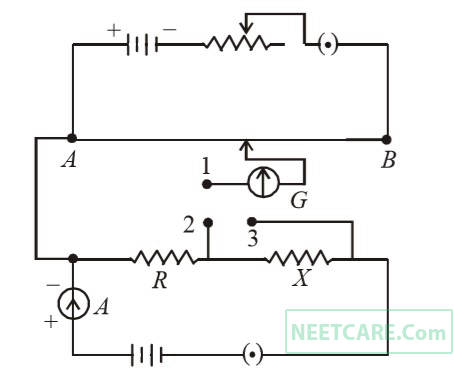1
AIPMT 2010 Prelims
MCQ (Single Correct Answer)
+4
-1
A lens having focal length f and aperture of diameter d forms an image of intensity I. Aperture of diameter $${d \over 2}$$ in central region of lens is covered by a black paper. Focal length of lens and intensity of image now will be respectively
2
AIPMT 2010 Prelims
MCQ (Single Correct Answer)
+4
-1
A potentiometer circuit is set up as shown. The potential gradient, across the potentiometer wire, is k volt/cm and the ammeter, present in the circuit, reads 1.0 A when two way key is switched off. The balance points, when the key between the terminals (i) 1 and 2 (ii) 1 and 3, is plugged in, are found to be at length $$l$$1 cm and $$l$$2 cm respectively. The magnitudes, of the resistors R and X, in ohms, are then, equal, respectively, to


3
AIPMT 2010 Prelims
MCQ (Single Correct Answer)
+4
-1
Charge q is uniformly spread on a thin ring of radius R. The ring rotates about its axis with a uniform frequency $$f$$ Hz. The magnitude of magnetic induction at the center of the ring is
4
AIPMT 2010 Prelims
MCQ (Single Correct Answer)
+4
-1
A galvanometer has a coil of resistance 100 ohm and gives a full scale deflection for 30 mA current. If it is to work as a voltmeter of 30 volt range, the resistance required to be added will be
Paper analysis
Total Questions
Biology
92
Chemistry
46
Physics
50
More papers of NEET
NEET 2025
NEET 2024 (Re-Examination)
NEET 2024
NEET 2023 Manipur
NEET 2023
NEET 2022 Phase 2
NEET 2022 Phase 1
NEET 2021
NEET 2020 Phase 1
NEET 2019
NEET 2018
NEET 2017
NEET 2016 Phase 2
NEET 2016 Phase 1
AIPMT 2015
AIPMT 2015 Cancelled Paper
AIPMT 2014
NEET 2013 (Karnataka)
NEET 2013
AIPMT 2012 Mains
AIPMT 2012 Prelims
AIPMT 2011 Mains
AIPMT 2011 Prelims
AIPMT 2010 Mains
AIPMT 2010 Prelims
AIPMT 2009
AIPMT 2008
AIPMT 2007
AIPMT 2006
AIPMT 2005
AIPMT 2004
AIPMT 2003
AIPMT 2002
AIPMT 2001
AIPMT 2000
NEET
Papers
2014
2009
2008
2007
2006
2005
2004
2003
2002
2001
2000